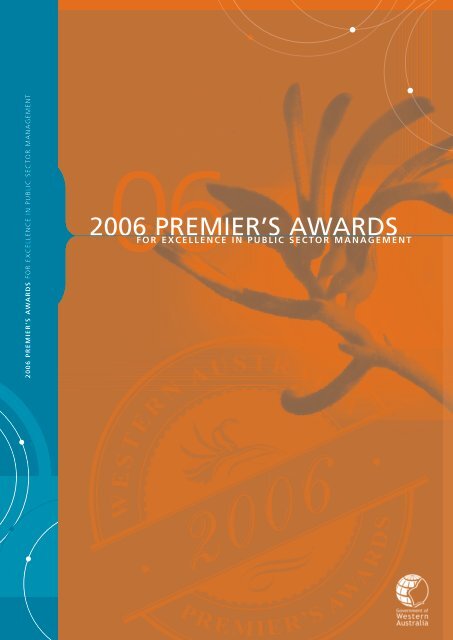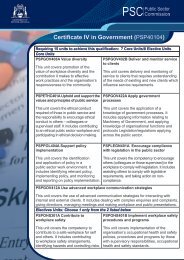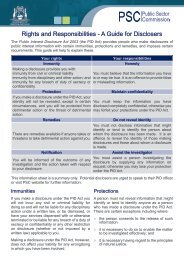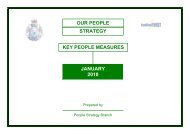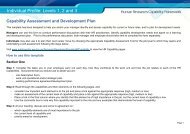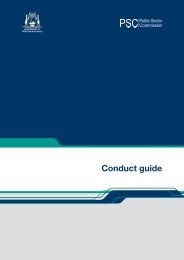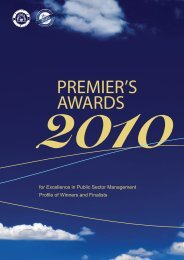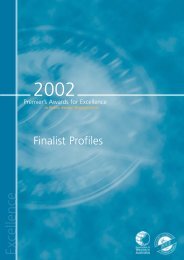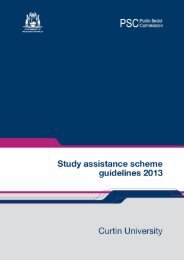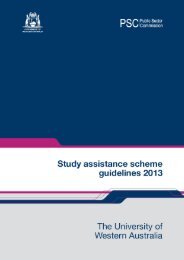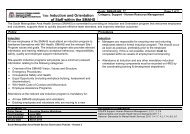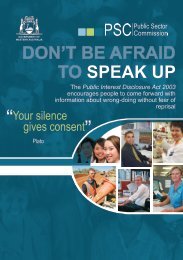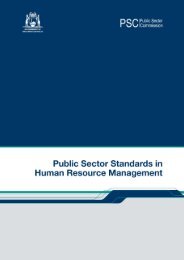Premier's Awards Profiles 2006 - Public Sector Commission - The ...
Premier's Awards Profiles 2006 - Public Sector Commission - The ...
Premier's Awards Profiles 2006 - Public Sector Commission - The ...
Create successful ePaper yourself
Turn your PDF publications into a flip-book with our unique Google optimized e-Paper software.
<strong>2006</strong> PREMIER’S AWARDS FOR EXCELLENCE IN PUBLIC SECTOR MANAGEMENT<br />
06<br />
F O R E X C E L L E N C E I N P U B L I C S E C T O R M A N A G E M E N T<br />
<strong>2006</strong> PREMIER’S AWARDS
FOREWORD<br />
I am very pleased<br />
to present the<br />
finalists for the <strong>2006</strong><br />
Premier’s <strong>Awards</strong> for<br />
Excellence in <strong>Public</strong><br />
<strong>Sector</strong> Management.<br />
Now in its<br />
eleventh year, the<br />
Premier’s <strong>Awards</strong><br />
are attracting a<br />
high calibre of<br />
submissions. We received a total of 68 submissions<br />
for the five categories from Government<br />
departments, statutory authorities, local<br />
governments and hospitals.<br />
<strong>The</strong> level of interest by agencies nominating<br />
their initiatives remains solid and the diversity<br />
and quality of submissions compared with other<br />
years has certainly been maintained.<br />
<strong>The</strong> aim of the <strong>Awards</strong> is to motivate and inspire<br />
agencies to strive for sustainable excellence,<br />
innovation and creativity in meeting the<br />
community’s needs. <strong>The</strong>y also serve as a primary<br />
vehicle to recognise and celebrate world-class<br />
achievements by those involved in the delivery<br />
of public services.<br />
Thank you to all agencies that submitted projects<br />
and programs for this year’s <strong>Awards</strong>. I trust the<br />
process of developing the submission was a<br />
valuable experience, providing individuals and work<br />
teams with an opportunity to undertake assessment<br />
and reflection on the outcomes of these initiatives.<br />
I also extend a special thank you to the Peak<br />
Judging Panel that comprised eminent persons<br />
from academia, industry, the private sector and<br />
the Western Australian community.<br />
Throughout this publication there are many<br />
examples of responsive management, leadership<br />
and collaboration that have resulted in better<br />
services to the community of Western Australia.<br />
I highly recommend all Directors General and Chief<br />
Executive Officers circulate these finalist profiles<br />
amongst their staff as a testament to agency<br />
enterprise and innovation.<br />
I congratulate all agencies and work teams<br />
recognised for their outstanding contributions to<br />
the <strong>2006</strong> Premier’s <strong>Awards</strong> for Excellence in <strong>Public</strong><br />
<strong>Sector</strong> Management.<br />
ALAN CARPENTER MLA<br />
PREMIER; MINISTER FOR PUBLIC SECTOR MANAGEMENT<br />
OVERALL WINNER<br />
<strong>2006</strong> PREMIER’S AWARD FOR EXCELLENCE IN PUBLIC SECTOR MANAGEMENT<br />
Department of Fisheries<br />
Recovery of Shark Bay’s Inner Gulf Pink Snapper Populations 1995-<strong>2006</strong><br />
<strong>The</strong> Peak Judging Panel’s role of selecting an overall winner for such a prominent award is certainly a challenging<br />
one. Nevertheless, rigorous evaluation produced clear and unanimous agreement that the Department of Fisheries’<br />
Recovery of Shark Bay’s Inner Gulf Pink Snapper Populations 1995-<strong>2006</strong> was the most outstanding and deserving<br />
submission of this high accolade.<br />
Three unique and vulnerable pink snapper populations located in the Shark Bay inner gulfs would have been<br />
devastated if the Department of Fisheries had not developed and implemented an innovative and engaging research<br />
and management program spanning the last decade - a world first for the management of finfish fisheries where<br />
recreational fishing dominates.<br />
In response to community concern, research was undertaken in 1995 that indicated that better coastal access and<br />
advanced fishing technology had led to coastal fish stocks across the remote northern regions being exposed to<br />
unprecedented levels of pressure from recreational fishers.<br />
To combat the over-exploitation committed planning, strategies, operations and the use of effective communication,<br />
innovation, monitoring and measurement were coordinated by the Department of Fisheries. This integrated approach<br />
resulted in enthusiastic and dedicated stakeholder support that has helped to turn around the decline of the pink<br />
snapper fishery in the region and place this popular fish species firmly back on a sustainable footing.<br />
Panel consensus indicated that the Recovery of Shark Bay’s Inner Gulf Pink Snapper Populations 1995-<strong>2006</strong> project<br />
impressively addressed all Award category criteria, particularly, modelling the way through community partnership<br />
and collaboration, agency goal achievement through high innovation and sustainability, and the enhancement of<br />
the Western Australian lifestyle through the protection and conservation of our natural and built environment.<br />
<strong>The</strong> ten year journey of discovery has made a significant contribution to many of the key issues associated with<br />
managing human impacts on wild fish populations for the benefit of the local community, fishing and tourism<br />
industries, the Western Australian economy and broader global environment. Signs are encouraging that this world<br />
heritage area, and other marine conservation areas, can co-exist with recreational fishing if good information,<br />
good science, good regulation and good collaboration are in place to support sustainable fishing.<br />
<strong>The</strong> Department of Fisheries is to be congratulated for its leadership in this groundbreaking long-term recovery<br />
project, which has ensured the long term viability of one of Western Australia’s valuable social, environmental<br />
and economic resources.<br />
3
<strong>2006</strong> PREMIER’S AWARDS FOR EXCELLENCE IN PUBLIC SECTOR MANAGEMENT<br />
BETTER SERVICES - LARGE ORGANISATIONS<br />
CATEGORY WINNER – State Library of Western Australia<br />
Better Beginnings Family Literacy Program<br />
Early years research shows that learning to read is the<br />
single most important factor in school success and that<br />
an early exposure to books and stories substantially<br />
contributes to success in early literacy.<br />
Despite this compelling evidence, there has not<br />
previously been a comprehensive program in Western<br />
Australia to target early literacy. In response to this, the<br />
State Library of Western Australia has taken the lead and<br />
developed Better Beginnings, an early intervention family<br />
literacy program that targets children aged 0 to 3 years.<br />
Better Beginnings recognises this early years research<br />
and best practice and focuses on working in partnership<br />
with families and communities to support children’s early<br />
literacy and learning.<br />
Funding from the State Government, the Rio Tinto WA<br />
Future Fund and Western Australian local governments<br />
provides a strong sustainable program. It takes advantage<br />
of the window of opportunity that presents itself in a<br />
child’s first three years to develop the necessary pre-literacy<br />
skills to ensure that they begin school ready to learn.<br />
Better Beginnings has already reached almost 45,000<br />
families, from Kununurra to Esperance and almost<br />
everywhere in between. Seventy local governments<br />
will take part in <strong>2006</strong>/07 e.g. 50 regional and remote<br />
communities including Halls Creek, Coolgardie, Karratha,<br />
Albany, Bunbury, Collie, Merredin and Kondinin, along<br />
with 22 communities throughout the metropolitan area.<br />
<strong>The</strong> program has been designed using a strong<br />
collaborative approach, capitalising on the shared goals<br />
of health and library professionals, in reaching and<br />
communicating with families of young children. Through<br />
Better Beginnings, the State Library partners with public<br />
libraries to provide a hub for early literacy activities that<br />
support families and develop links with early literacy<br />
professionals to reach out to their communities.<br />
Better Beginnings activities resonate with the fun and<br />
satisfaction that comes from parents bonding with their<br />
babies when they share books. <strong>The</strong> program has shown<br />
itself to be a comprehensive, practical and effective<br />
family literacy model that builds relationships between<br />
families and literacy resources in the community to open<br />
the door to a lifetime of literacy and learning for young<br />
Western Australians.<br />
FINALISTS<br />
Department of Corrective Services<br />
- High Commendation<br />
Better Services, Safer Communities<br />
- Re-Entry Programs for Prisoners<br />
<strong>The</strong> Department of Corrective Services’ community reentry<br />
programs are achieving outstanding success in<br />
reducing prisoner re-offending.<br />
<strong>The</strong>y are a different solution to a very complex problem<br />
that has been raising community concern for years.<br />
Re-entry Link began in March 2004 and the Transitional<br />
Accommodation Support Service (TASS) began in<br />
July 2003. <strong>The</strong>y are delivered through a network of<br />
contracted community providers, which act as case<br />
management coordinators, linking with Government and<br />
non-government providers to deliver services. <strong>The</strong>y come<br />
together through an innovative web-based information<br />
and management system, developed by the Department<br />
of Corrective Services.<br />
<strong>The</strong>se services are producing excellent results. Latest<br />
statistics show Re-entry Link clients have an indicative<br />
return-to-prison-rate of only 20 percent (in the first<br />
12 months), compared with the underlying current<br />
official return-to-prison-rate of 40.6 percent (measured<br />
after a two-year period). Also, in stark contrast to<br />
many programs of this nature, the participation rate<br />
by Aboriginal clients has increased to more than<br />
50 percent. This is a major achievement for such a<br />
challenging service where participation is voluntary.<br />
Of the 81 participants in the TASS program in the last<br />
12 month period, the return-to-prison rate is just 27.2<br />
percent overall and 18.8 percent for Aboriginal males.<br />
<strong>The</strong>se are particularly impressive results for a program<br />
with limited places made available only to offenders<br />
at a high risk of returning to prison. <strong>The</strong> low return-toprison<br />
rate for Aboriginal males is particularly impressive<br />
given the participation rate for this group has peaked<br />
at 50 percent.<br />
A web-based reporting framework, established in early 2004,<br />
provides continuous monitoring and reporting so that the<br />
Department of Corrective Services can measure the program’s<br />
success. This framework is supported by strong governance<br />
arrangements, which effectively engage both the front line<br />
service providers and the many agency groups who make up the<br />
service network.<br />
<strong>The</strong>se services have demonstrated major innovation in ‘joinedup’<br />
service design and the results signal a major change in<br />
re-offending, which addresses one of the most difficult and<br />
intractable issues in the correctional system.<br />
Main Roads Western Australia<br />
<strong>The</strong> Development and Implementation of<br />
Main Roads’ Customer Contact Centre<br />
An Australian first is providing Western Australian road users<br />
with extensive assistance and support as they travel the 17,800<br />
kilometre road network each day.<br />
Main Roads is responsible for the State’s $19 billion classified road<br />
network including traffic regulation and access for freight vehicles<br />
on local and State roads.<br />
In 2004, a new <strong>Commission</strong>er brought a vision for excellence<br />
in customer service to Main Roads, commencing a journey to<br />
achieve this vision with the development and implementation<br />
of the Customer Service Strategy, “Excellence Inroads”.<br />
A major review of communication channels undertaken as part of<br />
the development of the strategy recommended the centralisation<br />
of services into a “one stop shop” Customer Contact Centre<br />
(CCC). It identified that a CCC would provide a better service to<br />
the community, substantial financial, economic and environmental<br />
benefit to Main Roads and the WA community, and contribute to<br />
a safer and more sustainable road network.<br />
<strong>The</strong> Main Roads CCC, the first of its kind for an Australian<br />
State road authority, commenced business hours operation in<br />
March 2005, and went on to 24 hour a day, seven day a week<br />
operations in July that same year. <strong>The</strong> key deliverables and<br />
objectives for the CCC revolved around gaining efficiencies<br />
through process improvement, providing a better level of service<br />
to the community, and using customer feedback and input to<br />
drive business improvement.<br />
In July <strong>2006</strong>, Main Roads commissioned an external auditor to<br />
determine the actual savings derived from the establishment of<br />
the CCC. It found that almost all of the tangible benefits have<br />
been realised, confirming that the CCC is a value for money<br />
investment by Main Roads that will continue to be self-sustaining<br />
well into the future.<br />
Department of Health<br />
(South Metropolitan Area Health Service)<br />
Kaleeya Hospital Maternity Unit<br />
In December 2005, the Minister for Health announced that the<br />
iconic Woodside Maternity Hospital in East Fremantle would<br />
close, with services transferred to a new maternity unit to be<br />
established at the nearby Kaleeya Hospital.<br />
Closing a hospital at any time is a difficult task. For this project, the<br />
job was made more difficult by an extremely challenging operating<br />
environment that included an active opposition lobby group, a<br />
highly sensitive political climate, stretched internal resources, and an<br />
extremely tight timeframe of only three months.<br />
To achieve success, the project team planned and implemented<br />
a first-class logistical program that encompassed a massive scope<br />
of work – from building and construction, human resource<br />
management and communications, to clinical services planning<br />
and financial management.<br />
An innovative working party structure was developed to ensure the<br />
service delivery and facilities at the new unit would be first-class and<br />
would encompass the views of a wide range of stakeholders.<br />
A personal, hands-on approach facilitated the smooth transition<br />
of staff and antenatal clients, and was backed by a comprehensive<br />
communications program for the local community and wider<br />
industry sector.<br />
<strong>The</strong> result was nothing short of remarkable. After a previously<br />
unsuccessful attempt, the Minister for Health was able to close<br />
Woodside with significant support and very little public backlash.<br />
<strong>The</strong> new maternity unit at Kaleeya - which opened as planned<br />
in April <strong>2006</strong> - offers modern, custom-built facilities coupled<br />
with a service delivery that is second-to-none.<br />
This project demonstrated absolute excellence in its planning,<br />
delivery and results - and is an outstanding example of the<br />
delivery of better health services for all Western Australians.<br />
Department for Planning and Infrastructure<br />
<strong>The</strong> Introduction of the Recreational Skipper’s<br />
Ticket for Western Australia<br />
<strong>The</strong> Recreational Skipper’s Ticket (RST) is an outstanding example<br />
of the creation of better, high-quality services which provide real<br />
benefits for the Western Australian community.<br />
Last year six lives were lost in WA and just less than 300 marine<br />
search and rescues were undertaken as a result of boating incidents.<br />
<strong>The</strong> aim of the RST is to minimise deaths and injuries on the<br />
water as well as reduce the number of very costly marine rescues<br />
by ensuring recreational boat operators have the appropriate<br />
knowledge and skills to safely skipper their vessel and enjoy the<br />
State’s waters.<br />
For the first time, recreational skippers must demonstrate they are<br />
competent in a minimum standard of safety theory and practice<br />
before they are authorised to operate a registered vessel on<br />
WA waters.<br />
Despite having more than two years to comply, more than 20,000<br />
skippers have applied for the RST since its launch in February<br />
<strong>2006</strong>. An estimated 160,000 will have completed the training<br />
and assessment process by the time it becomes enforceable on<br />
1 April 2008 (or 1 April 2007 for under 25s).<br />
Marine safety officers from within the Department worked for<br />
more than two years with the boating industry, training providers,<br />
marine safety experts and recreational boaters to develop the RST.<br />
<strong>The</strong> resulting scheme is workable, cost-effective, efficient and it is<br />
also well supported.<br />
<strong>The</strong> RST represents the development and delivery of new and<br />
improved services, which will play a valuable role in saving lives<br />
on WA waters.<br />
5
<strong>2006</strong> PREMIER’S AWARDS FOR EXCELLENCE IN PUBLIC SECTOR MANAGEMENT<br />
BETTER SERVICES - SMALL ORGANISATIONS<br />
CATEGORY WINNER – Dampier Port Authority<br />
Port Security – Lending a Helping Hand<br />
<strong>The</strong> Dampier Port Authority (DPA) has broken new<br />
ground with its innovative and professional approach<br />
to the introduction of the new Maritime Security<br />
Identification Card (MSIC) - a Federal Government<br />
initiative to improve Australia’s maritime security.<br />
Despite being a regional port - faced with the challenges<br />
of working in a remote area - the quality of the services,<br />
technology and processes the DPA has developed in<br />
establishing its MSIC Office have been extremely high<br />
- so much so that they have served as examples to the<br />
Commonwealth Department of Transport and Regional<br />
Services and other ports around Australia.<br />
<strong>The</strong> software developed by the small team at the<br />
DPA - with input from the Fremantle Port Authority -<br />
to implement and manage the MSIC has proven so<br />
effective and far superior to anything else developed,<br />
it has been provided at no cost to regional ports around<br />
Western Australia.<br />
<strong>The</strong> DPA has also made available its website module,<br />
hard copy application and correspondence to all other<br />
WA regional ports. This has not only saved considerable<br />
development costs for those ports and the State, it has<br />
greatly assisted them in making the difficult and complex<br />
decision as to whether to become an issuing body in<br />
their region or not.<br />
<strong>The</strong> DPA’s mobile service for processing and issuing the<br />
MSIC, developed in consultation with Pilbara industry,<br />
is an excellent example of the authority’s collaborative<br />
approach to management and its ongoing commitment<br />
to improving services for port users, ultimately promoting<br />
the continued growth and expansion of the port.<br />
<strong>The</strong> willingness to share information, advice and serve<br />
as a point-of-contact for other ports are further<br />
examples of the DPA’s outstanding performance and<br />
how it has forged the way for the introduction of the<br />
MSIC - increasing safety and security not only at the Port<br />
of Dampier, but State-wide.<br />
FINALISTS<br />
Law Reform <strong>Commission</strong> of Western<br />
Australia - High Commendation<br />
Aboriginal Customary Laws Project:<br />
<strong>The</strong> Interaction of Western Australian<br />
Law with Aboriginal law and culture<br />
In December 2000 the Law Reform <strong>Commission</strong> of<br />
Western Australia (‘the <strong>Commission</strong>’) was presented<br />
with wide-ranging terms of reference to investigate<br />
whether there was a need for the Western Australian<br />
legal system to recognise the existence of Aboriginal<br />
customary laws.<br />
During its six-year inquiry the <strong>Commission</strong> consulted<br />
widely with representatives of the Aboriginal community<br />
and sought advice on the best way to proceed with<br />
a project of this sensitive nature and magnitude.<br />
On the basis of this advice the <strong>Commission</strong> implemented<br />
a culturally appropriate phased project structure.<br />
<strong>The</strong> effectiveness of the <strong>Commission</strong>’s collaboration<br />
with Aboriginal people is demonstrated by the fact<br />
that the <strong>Commission</strong> significantly extended the range<br />
of its project in response to concerns expressed by<br />
Aboriginal people in its consultations. <strong>The</strong> ongoing<br />
input from Aboriginal people has been vital to the<br />
success of the project.<br />
<strong>The</strong> project has a wide ambit: the <strong>Commission</strong> was<br />
required to investigate the interaction between<br />
Aboriginal people and a number of government<br />
agencies. This investigation required consultation with<br />
those agencies and the <strong>Commission</strong>’s discussion paper<br />
made proposals directed to improving their policies<br />
and practices. <strong>The</strong> <strong>Commission</strong> has demonstrated a<br />
commitment to ‘joined-up’ government services both in<br />
the way that it has conducted this project and also in its<br />
lead recommendation which proposes the adoption of a<br />
genuine whole-of-government approach to the design,<br />
development and delivery of services and programs to Aboriginal<br />
people in Western Australia.<br />
In August <strong>2006</strong> the project entered its closing phase as the<br />
<strong>Commission</strong> prepared to publish its final report. Throughout<br />
each stage of this project the <strong>Commission</strong> has provided excellent<br />
service to the Government of Western Australia through its<br />
carefully planned methodology, thorough research and extensive<br />
collaboration with the Aboriginal community. <strong>The</strong> <strong>Commission</strong><br />
recognised that the topics it needed to address in order to<br />
properly advise government about the recognition of Aboriginal<br />
customary law would require the adaptation of the traditional<br />
law reform model. <strong>The</strong> result is a unique project in law reform in<br />
Australia and a significant contribution to the advancement of<br />
Aboriginal people in this state.<br />
Office for Children and Youth<br />
Cadets WA<br />
Over the last 10 years, Cadets WA has emerged as the largest,<br />
most successful State Government-funded youth development<br />
program in Western Australia.<br />
Cadets WA has provided thousands of young people all over the<br />
State with leadership and development opportunities in a range<br />
of different fields from humanitarian to environmental.<br />
Cadets WA is about learning useful skills while having fun.<br />
Cadets learn valuable life skills, such as communication,<br />
leadership, independence and responsibility.<br />
<strong>The</strong> nine different cadet types give young people the opportunity<br />
to learn a range of practical skills such as bush survival, first aid,<br />
seamanship, flying, swimming, fire safety and much more.<br />
Cadets WA brings out the best in its members, inspiring<br />
confidence, encouraging self discipline and improving social skills.<br />
All over the State, cadets work on various projects, train for<br />
upcoming events and learn new skills to assist them achieve their<br />
current and future goals. Schools hosting a cadet unit also gain<br />
enormous benefit from participation.<br />
<strong>The</strong> cadet unit often becomes the central point for leadership<br />
activities within the school, encouraging students to become<br />
active in local events and give back to their communities.<br />
Now in the tenth year of development, Cadets WA has a fresh,<br />
new image and modern approach to encourage more young<br />
people to become involved.<br />
With 6,389 Cadets and 742 adult volunteers participating in one of<br />
197 units across the State, Cadets WA is ‘Better than you imagine’.<br />
7
<strong>2006</strong> PREMIER’S AWARDS FOR EXCELLENCE IN PUBLIC SECTOR MANAGEMENT<br />
JOBS AND ECONOMIC DEVELOPMENT<br />
CATEGORY WINNER – Tourism Western Australia<br />
Online Marketing Campaigns<br />
<strong>The</strong> internet is fast becoming the best source of<br />
information for travellers and its use for purchasing<br />
tourism products is also growing rapidly. Figures show<br />
that 48 percent of international visitors to Western<br />
Australia are researching or planning their trip on the<br />
internet, with government tourism sites a key resource<br />
for this audience.<br />
With this in mind, Tourism Western Australia is<br />
increasingly engaging in Online Marketing Campaigns,<br />
as the internet offers targeted and cost-effective<br />
communication with a much broader reach than<br />
traditional marketing approaches.<br />
Tourism Western Australia’s websites are key marketing<br />
tools for Western Australia, with its main consumer<br />
website westernaustralia.com motivating and inspiring<br />
consumers from around the world to visit Western<br />
Australia. This online gateway is also a comprehensive<br />
resource for consumers planning their visit to the State.<br />
In the last financial year, unique visitors to the site<br />
increased by a record 61.5 percent, to 1.5 million unique<br />
users, and page impressions also broke records, with<br />
approximately 11.5 million impressions generated.<br />
<strong>The</strong> agency’s main Online Marketing Campaigns of<br />
2005/06 targeted the interstate, New Zealand and<br />
United Kingdom markets. Supporting data during this<br />
period shows the strategic campaigns helped increase<br />
visitation. Building on this success, Tourism Western<br />
Australia also launched Chinese, Japanese and Korean<br />
language websites and was the first ever Australian<br />
tourism body to conduct online campaigns of this kind<br />
in these markets. <strong>The</strong> online campaigns in each of these<br />
local markets were a great success, attracting 58,000<br />
unique visitors collectively.<br />
Post-campaign surveys (conducted by an independent<br />
agency) show an increased interest in visiting WA as a<br />
direct result of online marketing campaign activity.<br />
From March to June <strong>2006</strong>, 79 percent of respondents said<br />
the interstate online campaign made them more interested<br />
in visiting WA, and 75 percent of respondents said the<br />
United Kingdom online marketing campaign from January<br />
to April <strong>2006</strong> made them more interested in visiting WA.<br />
<strong>The</strong> online campaigns also helped grow regional tourism<br />
through several methods, including encouraging users<br />
to explore all featured content on websites, giving small<br />
regional operators qualified leads through the agency’s<br />
customer database of more than 220,000 people and<br />
free advertising of local monthly operator specials such as<br />
accommodation and tours on westernaustralia.com.<br />
<strong>The</strong>se fantastic results from award winning campaigns<br />
help build long term awareness, interest and ultimately<br />
desire among consumers to visit Western Australia in an<br />
incredibly competitive global market. A higher level of<br />
desire boosts the local economy and creates more jobs<br />
over the long term.<br />
FINALISTS<br />
Department of Corrective Services<br />
Prisoners Fill Labour Skills Shortages<br />
While many employers are looking overseas to fill<br />
unprecedented vacancies in the skilled labour market, an<br />
innovative program is creating a ready labour force right<br />
here in Western Australia - with excellent results.<br />
<strong>The</strong> Labour Market Skills program, developed by the<br />
Department of Corrective Services, taps into an under<br />
utilised labour pool - prisoners - and trains them<br />
specifically in industries where there are skills shortages.<br />
<strong>The</strong>se industries - including construction, hospitality and<br />
agriculture - are then approached by the Department of<br />
Corrective Services to secure employment for prisoners<br />
upon release.<br />
<strong>The</strong> results are outstanding and provide considerable<br />
economic gain for the community.<br />
Based on the 100 prisoners placed in employment<br />
under the program in the first six months of <strong>2006</strong>, the<br />
estimated savings to the community (in productivity and<br />
imprisonment) will be approximately $1.5 million per<br />
annum if each continues in employment and doesn’t<br />
return to prison.<br />
A recent survey of prisoners who completed traineeships in<br />
2004/05 and who have since been released from custody shows<br />
that an impressive 71 percent were employed in the community,<br />
with 80 percent being employed in the industry in which they<br />
received training.<br />
<strong>The</strong>se people, traditionally from disadvantaged backgrounds, are<br />
being given an opportunity for a much improved quality of life.<br />
Many have not previously been employed at all and often not<br />
where their skills and contribution were valued and sought<br />
after by industry.<br />
As well as providing a steady income, these jobs play an<br />
important role in keeping ex-prisoners from re-offending.<br />
International research has identified not having a job as one<br />
of the most important factors in re-offending, reducing the<br />
rate from between a third to a half.<br />
Under the program, approximately 6,500 prisoners undertook<br />
training in 2005/06, providing much needed labour resources<br />
for the community on release from prison.<br />
Western Australia Police<br />
International Police Recruiting<br />
At a time when the economy of the State is at an all time<br />
high and the labour market is under tremendous pressure, the<br />
Western Australia Police faced the significant risk of not being<br />
able to maintain approved staffing levels, let alone delivering<br />
on the Government’s commitment to increase the number of<br />
uniform officers by 350.<br />
<strong>The</strong> current world security crisis has brought pressure to policing<br />
across Australia. Highly skilled and professional police officers<br />
from Australian jurisdictions have been sought after by Federal<br />
agencies and overseas organisations to fill a variety of roles and<br />
responsibilities.<br />
<strong>The</strong> health of the economy has translated into opportunities<br />
for people to leave policing and to move into a variety of<br />
employment areas across the public and private sector.<br />
All of these issues coming together made it obvious that ‘the way<br />
we always do things’ was not going to address the employment<br />
risk facing the Western Australia Police. In September 2005 the<br />
Police Academy developed an overseas recruiting campaign that<br />
was innovative, effective and went on to deliver proven results.<br />
<strong>The</strong> International Police Recruiting program has achieved<br />
outcomes consistent with organisational goals and government<br />
directions. In the recent Corruption and Crime <strong>Commission</strong><br />
document ‘Two Years Out – A report of the First Two Years of the<br />
Western Australia Police Reform Program’ it was noted that the<br />
Academy has adopted “innovative recruitment strategies”.<br />
Through negotiation with the Department of Immigration and<br />
Multicultural Affairs, the Western Australian Agent General in<br />
London, the State Government, and numerous private sector<br />
organisations the Western Australia Police has successfully<br />
employed 63 International Police Recruiting Program officers and<br />
made offers of employment to a further 166 officers.<br />
9
<strong>2006</strong> PREMIER’S AWARDS FOR EXCELLENCE IN PUBLIC SECTOR MANAGEMENT<br />
LIFESTYLE AND THE ENVIRONMENT<br />
CATEGORY WINNER – Department of Fisheries<br />
Recovery of Shark Bay’s Inner Gulf Pink Snapper Populations 1995-<strong>2006</strong><br />
Pink snapper: it’s the first choice for many people visiting<br />
the fish and chip shop, or buying fresh at the fishmonger.<br />
It’s also a very popular quarry for the recreational angler<br />
– many of whom are drawn to Shark Bay each year to<br />
fish for this popular species.<br />
In the inner gulfs of Shark Bay, pink snapper populations<br />
are unique with three distinct populations that do not<br />
interbreed. <strong>The</strong> species is slow-growing and long-lived<br />
and hence is vulnerable to over-exploitation and<br />
environmental change.<br />
In winter, Shark Bay snapper form large schools or<br />
“aggregations” to spawn - the very time that weather<br />
conditions in the sheltered inner gulfs are ideal for<br />
recreational boating. Many anglers head to the area<br />
for a spot of sunshine and to throw in a line. Helped<br />
by faster boats, technology and sealed roads leading to<br />
boat ramps and fishing spots, the fishers’ haul increased<br />
dramatically between 1983 (2,500 pink snapper caught)<br />
and 1995 (over 11,000).<br />
Concerns from the local community led to an initiative to<br />
save the pink snapper population from collapse.<br />
<strong>The</strong> Department of Fisheries embarked on an innovative<br />
management and research program – in reality a<br />
ten year journey of discovery, engaging the support<br />
and involvement of numerous individuals and groups<br />
from the community and government.<br />
This journey was more than an effort to restore fish<br />
stocks; it was an exploration into the scientific and social<br />
issues associated with managing human impacts on<br />
wild fish populations, and ultimately safeguarding the<br />
sustainability and biodiversity of these valuable social<br />
and economic resources.<br />
Ten years on, following an innovative management and<br />
research program, snapper stocks in the three areas -<br />
Denham Sound, the Eastern Gulf and the Freycinet Estuary<br />
- have recovered, or are well on the road to recovery.<br />
<strong>The</strong> recovery of the Shark Bay’s inner gulf pink snapper<br />
populations employed a series of successful strategies<br />
based on the principles of adaptive management.<br />
It involved the building of community support, and<br />
ultimately the establishment of a clear set of achievable,<br />
measurable, outcome focused objectives based firmly on<br />
the biological and ecological characteristics of the fish<br />
populations under pressure.<br />
FINALISTS<br />
Department for Planning and Infrastructure<br />
- High Commendation<br />
Perth Bicycle Network.<br />
<strong>The</strong> Perth Bicycle Network (PBN) has established<br />
750 kilometres of cycle and shared paths at a cost<br />
of $53 million.<br />
<strong>The</strong> program aims to place a bicycle facility within 750<br />
metres of every Perth household and is establishing<br />
cycling facilities at three levels:<br />
• Principal Shared Paths that run adjacent to railway<br />
lines and freeways and link a range of facilities,<br />
including bus and train stations;<br />
• Recreational Shared Paths that skirt river foreshores,<br />
the coastline and public open space corridors; and<br />
• Local Bicycle Routes that are a mixture of cycle<br />
friendly suburban streets and local shared paths that,<br />
where possible, link to major shared paths.<br />
<strong>The</strong> innovative design and construction techniques for<br />
cycling infrastructure used have become benchmarks for<br />
other States and Territories. Queensland has adopted Perth’s<br />
PBN model for its urban cycling system and the Austroads<br />
National Standards for cycling infrastructure were developed<br />
directly from standards set originally in Perth.<br />
<strong>The</strong> Metropolitan Transport Strategy, produced in 1995,<br />
set targets of a 35 percent reduction in car-as-driver trips<br />
over the next 25 years and for cycling levels to increase<br />
to eight percent of trips in Perth by 2010 and then to<br />
11.5 percent by 2029.<br />
<strong>The</strong> desire for an increased emphasis on cycling is<br />
reflected in the Network City Community Planning<br />
Strategy for Perth and Peel.<br />
Western Australia is currently achieving the largest growth<br />
in cycling in Australia and cycle use across all surveyed<br />
PBN sites has increased by 159 percent from 1998 to<br />
<strong>2006</strong> - an average annual increase of 20 percent.<br />
A range of sustainable environmental, economic, social<br />
and health benefits are flowing directly from the program,<br />
which is also satisfying the principles of a quality transport<br />
system – safety, efficiency, effectiveness, environmental<br />
responsibility, social responsibility and robustness.<br />
<strong>The</strong> program is being delivered through extensive<br />
collaboration between State and local government,<br />
the community and bicycle user groups.<br />
Department of Treasury and Finance<br />
Greening the WA Government’s Vehicle Fleet<br />
Global climate change, or global warming, is arguably the most<br />
important environmental issue of our day with real potential<br />
to impact adversely on the economy, society and environment.<br />
It respects no border, and its influence is being felt as much<br />
in Western Australia as it is globally. At the heart of this<br />
phenomenon are greenhouse gas emissions.<br />
State Fleet WA, which is responsible for the majority of the WA<br />
Government’s passenger and light commercial vehicles, has put in<br />
place an integrated program that firstly reduces the greenhouse<br />
gas emissions from its fleet of 10,000 vehicles, and secondly<br />
offsets the emissions that do occur.<br />
Under the banner of Greening the WA Government Vehicle Fleet,<br />
the program integrates three facets:<br />
• Large-scale replacement of six-cylinder vehicles with<br />
four-cylinder alternatives;<br />
• Requirement that a proportion of six-cylinder vehicles<br />
be LPG-powered; and<br />
• Environmental programs including revegetation and tree<br />
planting to offset the CO2 emission made by the vehicle fleet.<br />
<strong>The</strong> revegetation and tree-planting programs have a number<br />
of tangible environmental and community benefits in addition<br />
to the CO2 offset.<br />
<strong>The</strong> drive to more efficient and environmentally friendly<br />
four-cylinder vehicles and also LPG powered vehicles has been<br />
promoted through persistent targeted policy and education<br />
over several years. <strong>The</strong> carbon-offset program, by contrast, is a<br />
relatively new initiative. Following Cabinet approval, State Fleet<br />
and the then Department of Environment, worked closely in<br />
shaping a vehicle emission carbon-offset program that became<br />
effective this year.<br />
As the single largest fleet owner in Western Australia, State Fleet<br />
has provided leadership by example in a sensible and affordable way<br />
by promoting responsible environmental strategies. <strong>The</strong> integrated<br />
program not only provides these benefits but also achieves<br />
substantial savings in vehicle fleet costs, in the order of $2.25 million<br />
annually. <strong>The</strong> savings are expected to grow to over $4 million in the<br />
next year or so.<br />
City of Mandurah<br />
Bushland Protection Strategy<br />
In a Western Australian first the fastest growing regional city in<br />
the nation, the City of Mandurah, made a historical decision to<br />
purchase privately owned bushland, with the aim of saving it<br />
from development and protecting it now and into the future.<br />
Mandurah has experienced phenomenal growth with census<br />
information reflecting a growth surge of 1,500 percent from<br />
its 1971 resident population of 2,700 to an estimated 63,000<br />
in June <strong>2006</strong>.<br />
In line with the sea change movement around Australia,<br />
Mandurah has seen a ‘sea rush’, transforming the holiday shack<br />
landscape into a vibrant and modern regional city centre as<br />
many flocked to the city for an alternative and permanent<br />
lifestyle choice. However, the impact of significant population<br />
shifts has rapidly resulted in major land development acceleration<br />
and bustling building activity.<br />
As the population swelled and large parcels of land were<br />
cleared to accommodate the basic needs of this rapidly growing<br />
community, including homes, commercial sites, schools, medical<br />
and recreation facilities, issues surrounding the clearing of<br />
bushland become increasingly emotive.<br />
In a bold and savvy move, the City of Mandurah responded to<br />
its community’s desire to protect bushland by preparing and<br />
implementing the Bushland Protection Strategy.<br />
<strong>The</strong> Strategy achieves “Planet Objectives” of the Community<br />
Charter and Strategic Plan and reflects the community’s<br />
expectations for biodiversity conservation by setting a goal<br />
“to protect 150 hectares of privately owned bushland that<br />
will otherwise be developed”.<br />
In January <strong>2006</strong> the City celebrated with its community the first<br />
natural bushland purchase and negotiations are now underway<br />
to secure the second land parcel acquisition.<br />
<strong>The</strong>se positive outcomes demonstrate how, through a united<br />
approach, communities can accept and confront the challenge<br />
of balancing significant growth trends with the conservation<br />
of natural bushland and, move on to develop and implement<br />
sustainable solutions for its community, and its sustainable future.<br />
Rottnest Island Authority<br />
Rottnest Island Marine Management Strategy<br />
<strong>The</strong> Rottnest Island Marine Management Strategy has been a real<br />
achievement, developed over a period of two and a half years to<br />
draft stage. Its objectives are to enhance the lifestyle of Western<br />
Australians and other visitors to Rottnest Island, and to protect<br />
and conserve biodiversity in marine habitats identified as having<br />
high value.<br />
Its specific objectives are to provide:<br />
• Undisturbed areas of representative habitat for marine<br />
biodiversity conservation;<br />
• Marine education and nature appreciation opportunities;<br />
• Quality recreational fishing opportunities;<br />
• Scientific reference areas and the opportunity for marine<br />
scientific research; and<br />
• Appropriate and compatible commercial and private<br />
recreational water sports and activities.<br />
Recommendations in the draft Strategy are a “best fit”<br />
compromise between divergent opinions and expert views.<br />
Volunteers contributed 533 hours to its development, with<br />
participation from relevant stakeholders representing marine<br />
scientists, conservationists, recreational fishers, commercial<br />
operators, relevant government agencies, and the Rottnest Island<br />
Authority, (whose responsibility it is to protect the flora and fauna<br />
of the Marine Reserve, and provide recreational experiences for all<br />
Western Australians and other visitors). <strong>The</strong>y include:<br />
• Department of Fisheries<br />
• Outdoors Western Australia<br />
• WA Dive Tourism Association<br />
• Department of Conservation and Land Management<br />
• Charter Boat Owners Association<br />
• CSIRO<br />
• Conservation Council of Western Australia<br />
• RecFishWest<br />
• Rottnest Island Environmental Advisory Committee<br />
• Western Australia Museum<br />
• Rottnest Island Marine Issues Advisory Committee<br />
• Murdoch University<br />
<strong>The</strong> process for developing the draft Strategy has been described<br />
as approaching world best practice in the development of<br />
conservation areas by: first identifying and mapping conservation<br />
values; second, preparing candidate areas for reservation and<br />
zoning; third, considering stakeholder issues and costs, and<br />
adjusting boundaries and zonings to minimize stakeholder<br />
issues while meeting the biodiversity objectives; and fourth,<br />
implementing management strategies and monitoring systems.<br />
11
<strong>2006</strong> PREMIER’S AWARDS FOR EXCELLENCE IN PUBLIC SECTOR MANAGEMENT<br />
REGIONAL DEVELOPMENT<br />
CATEGORY WINNER – Department of Education and Training<br />
Follow the Dream - A Secondary School ‘Aspirations’ Strategy<br />
for Aboriginal Students<br />
Follow the Dream is the most significant secondary<br />
school retention program for Aboriginal students ever to<br />
be implemented in Western Australia.<br />
It supports the Gordon Inquiry’s call for agency responses<br />
resulting in enhanced retention of Aboriginal students<br />
to Year 12 and it supports the Department of Education<br />
and Training’s Aboriginal Education and Training<br />
Operational Plan 2005-2008.<br />
<strong>The</strong> program is currently being delivered to more than 600<br />
students in 10 metropolitan and 15 regional centres and<br />
is producing dozens of inspiring success stories among<br />
young Australians in regional locations across the State.<br />
It is on track to reach its goal of achieving a tenfold<br />
increase by 2008 in the number of Aboriginal students<br />
staying in secondary school and gaining entry to university.<br />
<strong>The</strong> program is managed by the Department of Education<br />
and Training, through the Indigenous Participation and<br />
Achievement Standards Directorate, in partnership with<br />
the Graham (Polly) Farmer Foundation and in collaboration<br />
with government, industry and community partners.<br />
Follow the Dream targets successful Aboriginal secondary<br />
school students and provides them with a supportive<br />
learning environment to enable them to complete school<br />
and go on to university.<br />
<strong>The</strong> program is based on extensive local community<br />
consultation and is delivered by local people at the local<br />
level, with a strong focus on building the capacity of<br />
regional communities.<br />
It is attracting significant financial support from corporate<br />
partners in regional areas, in support of their own<br />
community investment aims.<br />
Follow the Dream has its roots in the highly successful<br />
Gumala Mirnuwarni project which was supported by the<br />
Graham (Polly) Farmer Foundation in the north-west of<br />
the State.<br />
It draws on established success strategies and is<br />
underpinned by ground breaking research which<br />
is expected to make a major contribution to our<br />
understanding of effective Aboriginal education.<br />
FINALISTS<br />
Department of Water - High Commendation<br />
Rural Water Plan<br />
Since the beginning of agricultural development in<br />
Western Australia, water shortages have been common<br />
in dryland farming districts.<br />
Halfway through one of the driest years on record,<br />
farmland rural communities are facing the likelihood of<br />
water shortages during summer. That the situation is not<br />
more severe is in part testament to the success of the<br />
Department of Water’s Rural Water Plan in tackling the<br />
dual problem of lack of water and poor quality water.<br />
<strong>The</strong> Rural Water Plan (originally the Farm Water Plan)<br />
was released in 1995. It provides the framework for an<br />
organised and coordinated approach to the planning<br />
and implementation of farmland and community water<br />
supply improvements in dryland agricultural areas. Its key<br />
focus is to help broadacre farming businesses prepare<br />
more effectively for extended periods of low rainfall.<br />
Importantly, the Plan also recognises the relatively high<br />
risk faced by broadacre farmers in those districts not<br />
connected to piped water services and makes available<br />
services and incentives which offer the opportunity<br />
to lessen the impact of those risks and encourage<br />
sustainable land use.<br />
<strong>The</strong> Rural Water Plan comprises several program<br />
initiatives that are designed to address serious water<br />
deficiency by encouraging the development of reliable<br />
and good quality farmland water supplies.<br />
<strong>The</strong> achievements made possible since the Plan’s<br />
inception have been impressive: almost $24 million in<br />
grants to nearly 3,000 farmers by June <strong>2006</strong>, and grants<br />
amounting to $27 million allocated to 77 farmland<br />
community water supply projects. <strong>The</strong> contributions<br />
made by individual farmers and communities and total<br />
investment is almost $108 million.<br />
While noticeable improvements have been achieved,<br />
there are still areas that remain susceptible to serious<br />
water deficiency. Emerging climate change and predicted trends<br />
for drier and warmer conditions have ensured the Rural Water<br />
Plan remains one of the key mechanisms for addressing serious<br />
water deficiencies in regional Western Australia.<br />
City of Albany<br />
Great Southern Engineering Cadetship Program<br />
<strong>The</strong> Great Southern Civil Engineering Cadetship Program, which<br />
commenced in January <strong>2006</strong>, is an innovative regional response<br />
to the nationwide civil engineering skills shortage crisis.<br />
<strong>The</strong> City of Albany has taken a long-term approach to this problem<br />
and has devised a local solution, which has been implemented<br />
in partnership with the Shire of Plantagenet, Water Corporation,<br />
Main Roads Western Australia, Wood and Grieve Engineers, Opus<br />
International Consultants and Great Southern TAFE.<br />
In its first year of operation the program partners have employed<br />
a total of nine cadets who are being sponsored to attend Great<br />
Southern TAFE where they study part-time. <strong>The</strong> remainder of<br />
the time they are mentored by experienced engineers and other<br />
technical staff in the workplace.<br />
Over a three year period the cadets will complete the newly<br />
created Certificate IV Civil Engineering and Diploma of<br />
Engineering (Civil/Structural).<br />
This initiative has required the cultivation of high levels of<br />
collaboration between the partners and is already providing<br />
extensive support to the development of this region which is<br />
experiencing previously unheard of levels of investment.<br />
This program is an excellent example of leadership, innovation,<br />
collaboration and long-term investment for the benefit of the<br />
regional communities of the Lower Great Region.<br />
Fire and Emergency Services<br />
Authority of Western Australia<br />
Safer Country – Community Centred<br />
Emergency Risk Management Program<br />
<strong>The</strong> Fire and Emergency Services Authority (FESA) is providing<br />
better emergency management services to Western Australia’s<br />
remote Indigenous communities through the innovative ‘Safer<br />
Country - Community Centered Emergency Risk Management<br />
Program’. <strong>The</strong> program enhances the capacity of Indigenous<br />
people to identify, evaluate and treat risks to prevent or reduce<br />
the impact of emergencies in their own communities.<br />
Safer Country was developed by FESA’s Indigenous Programs<br />
Unit. <strong>The</strong> program forms part of an ongoing initiative to<br />
continuously improve the safety of Indigenous communities<br />
within Western Australia.<br />
Emergency risk management builds the capacity of communities<br />
to identify, analyse, evaluate and treat emergency risks for<br />
themselves. Emergency risk management forms an integral part<br />
of the emergency management framework recently formalised<br />
by the Emergency Management Act 2005.<br />
<strong>The</strong> program has enabled FESA, along with other service<br />
providers, to work together with communities to address risk.<br />
It has been operating in the following high risk communities:<br />
• Bardi/Ardyaloon, Beagle Bay, Lombadina, Djarindjin, and<br />
Bidyadanga in the West Kimberley;<br />
• Jingalong and Kiwirrkurra in the East Pilbara;<br />
• Warburton, Warakurna and Blacksone in Ngaanyatjarraku; and<br />
• Oombulgurri and Halls Creek in the East Kimberley.<br />
It has been successful in achieving government collaboration<br />
and community partnerships to engage those in remote areas to<br />
meet their safety responsibilities. Remote Indigenous communities<br />
have begun implementing risk treatment strategies, based on risk<br />
reduction principles, to deliver better emergency management<br />
activities and community safety outcomes.<br />
Department of Health (WA Country Health Service)<br />
CaterWise<br />
Obesity in children is recognised as a significant public health<br />
problem. Recent figures show 23 percent of boys and 30 percent<br />
of girls in Western Australia are overweight or obese. It is also<br />
known that the school environment has a powerful influence on<br />
students’ eating habits. School food services like canteens are<br />
an important way to shape children’s eating habits, but what if<br />
there is no school canteen on site? In WA, 400 schools must rely<br />
on a local shop or roadhouse to access school lunches for their<br />
students, presenting a major concern with the majority of items<br />
sold at these venues being deep fried food and soft drinks.<br />
CaterWise targets schools that do not have a canteen on site.<br />
It aims to increase the school community’s nutrition knowledge<br />
and menu planning skills, thus improving the nutritional content<br />
of the school lunch menu.<br />
CaterWise is a comprehensive and unique school-based program<br />
that delivers workshops (facilitated by dietitians and nutritionists)<br />
to parents, staff and school caterers to educate them about menu<br />
planning and healthy eating. It is an action-focussed program<br />
that encourages participants to actively plan and develop a school<br />
catering policy. Surveys are conducted with school communities to<br />
assess their needs and views in relation to healthy eating at school<br />
and the school lunch menu. A simple menu assessment tool<br />
allows objective assessment of school lunch menus, as a<br />
well as identification of key areas for improvement.<br />
CaterWise addresses the need to provide nutrition education and<br />
healthier school menus for schools without canteens. Ten schools<br />
in the rural Wheatbelt participated in a five-month workshop<br />
program, which resulted in several of them making significant<br />
changes to their school lunch menus and introducing nutrition<br />
policies. Over 76 percent of participants reported higher levels of<br />
knowledge in all areas covered by the workshops.<br />
<strong>The</strong> future of the program is to promote a shared vision of<br />
improved nutritional health of school aged children through<br />
engaging more rural schools throughout Western Australia.<br />
13
<strong>2006</strong> PREMIER’S AWARDS FOR EXCELLENCE IN PUBLIC SECTOR MANAGEMENT<br />
GOVERNANCE AND PUBLIC<br />
SECTOR IMPROVEMENT<br />
CATEGORY WINNER – Department of Corrective Services<br />
Working Smarter - Community and Juvenile Justice<br />
Strategic Management System<br />
<strong>The</strong> Department of Corrective Services Community and<br />
Juvenile Justice Division’s Strategic Management System<br />
(SMS) has revolutionised decision making relating to<br />
the sensitive business of managing offenders in the<br />
community.<br />
It provides unprecedented accuracy, certainty and<br />
timeliness in information provided to senior managers<br />
and allows integrated decision making which in turn<br />
increases accountability, responsiveness and transparency.<br />
<strong>The</strong> first of its kind in the Western Australian public<br />
sector, the SMS is an integrated, strategic management<br />
modelling system with three main components - longterm<br />
strategic business planning, annual budgeting<br />
and monthly monitoring and reporting.<br />
It centralises data within a software program that allows<br />
quick and easy financial monitoring and reporting as well<br />
as scenario modelling which means managers can<br />
“test drive” shifts in policy or resourcing.<br />
<strong>The</strong> system delivers senior management with accurate and<br />
easily accessible information so they are able to monitor<br />
performance and make sound decisions about budgeting<br />
and how best to meet demand, including resource<br />
allocation across the division and the Department.<br />
Accurately matching staff to demand, making decisions<br />
based on accurate and easily accessible information and<br />
forecasting the impact of policy or resourcing decisions<br />
were previously much more difficult.<br />
<strong>The</strong> ground-breaking modelling approach has resulted in<br />
better business planning, resource forecasting, budgeting,<br />
monitoring and reporting by allowing the user to alter<br />
variables and view the anticipated results. It has provided,<br />
for the first time, a verifiable, transparent budgeting model<br />
that can be rigorously tested, measured and trusted.<br />
<strong>The</strong> system is easily adaptable, and could be adopted<br />
across any number of Government agencies and tailored<br />
to better inform management.<br />
FINALISTS<br />
Department of Treasury and Finance<br />
- High Commendation<br />
Get the People Right and<br />
Procurement Delivers<br />
Three years ago the Western Australian Government<br />
embarked upon a program of procurement reform with<br />
the Department of Treasury and Finance (DTF) overseeing<br />
the implementation of programs directed at achieving<br />
cost savings and better procurement outcomes across<br />
the sector.<br />
DTF believes that skilled people who are happy in their<br />
employment achieve significantly greater benefits for<br />
themselves, their customers and ultimately the people<br />
of Western Australia. <strong>The</strong> ‘Get the People Right and<br />
Procurement Delivers’ philosophy has been a guiding<br />
principle in implementing initiatives that assist agencies<br />
achieve greater value for money in their procurement<br />
activities.<br />
<strong>The</strong> people dimension of the program saw the<br />
establishment of a government-wide team of<br />
procurement specialists to enhance the skills and<br />
professionalism of practitioners throughout the State<br />
public sector. Some of these undertakings included:<br />
• <strong>The</strong> transfer of 130 positions from the former<br />
Department of Industry and Technology<br />
to establish a Procurement Unit in DTF;<br />
• Rebadging of over 100 positions from 23 government<br />
agencies to create a single service centre; and<br />
• Teambuilding and professional development programs.<br />
<strong>The</strong> introduction of a government-wide team has<br />
delivered significant improvements to the way<br />
procurement is governed in Western Australia, including:<br />
• Significant cost savings of $47 million in 2004/05;<br />
• Faster procurement through new ‘pick and buy contracts’<br />
• Improved policies and processes;<br />
• Standardised contract documentation and new terms<br />
and conditions;<br />
• More effective contract development and management<br />
supported by a new whole-of-government technology<br />
platform;<br />
• Strengthened implementation of the ‘buy local’ policy<br />
through the establishment of Regional Buying<br />
Centres; and<br />
• Richer market and business intelligence.<br />
DTF’s commitment to the program has enhanced benefits and<br />
outcomes enabling substantial improvements to the delivery of<br />
procurement services to government agencies, with flow-on<br />
benefits to the State and people of Western Australia.<br />
Department of Housing and Works<br />
Fremantle Prison – A Living Legacy<br />
Faced with an unacceptable maintenance backlog and<br />
unsustainable business management model for Fremantle Prison<br />
(its leading heritage site), the Department of Housing and Works<br />
reviewed how the site was managed. This has resulted in radical<br />
changes that have not only protected the prison as a heritage icon,<br />
but turned it into a thriving tourism operation with a bright future.<br />
Prior to 2002, the site had been leased by private operators.<br />
However, at the end of the contract, the Department decided to<br />
take back the tourism operations under a new framework which<br />
would allow for the protection and conservation of the physical<br />
buildings as well as the sustainable business operation that would<br />
make the site self-funding.<br />
<strong>The</strong> Department undertook a master-planning project which<br />
involved extensive consultation with stakeholders, experts and<br />
the community to develop a new way of managing the site.<br />
<strong>The</strong> resulting integrated framework set realistic priorities for the<br />
future of the prison including conservation, tourism, commercial<br />
enterprise and ongoing maintenance.<br />
<strong>The</strong> process has become a leading example of best practice<br />
in governance and public sector management that is now<br />
recommended by the Commonwealth Department of<br />
Environment and Heritage to other heritage operations.<br />
<strong>The</strong> results achieved by the Department have been impressive.<br />
Fremantle Prison is now at a stage where it is generating sufficient<br />
funding to substantially meet operating costs, including spending<br />
on regular maintenance, marketing and public programs.<br />
Visitor numbers have grown by 50 percent with on-site<br />
employment almost trebling as a result. <strong>The</strong> level of income<br />
allocated to conservation and environmental maintenance has<br />
increased from $70,000 to $300,000 in just four years.<br />
<strong>The</strong> Department has shown how government can successfully<br />
operate profit activities within a transparent and accountable<br />
framework. <strong>The</strong> new governance arrangements have achieved<br />
outstanding results and made the project a role model across all<br />
levels of Government, State and Commonwealth.<br />
Department of Local Government<br />
and Regional Development<br />
Indigenous Governance and Leadership Program<br />
<strong>The</strong> abolition of the Aboriginal and Torres Straight Islander<br />
<strong>Commission</strong> (ATSIC) in 2003 has significantly increased the need<br />
for a new approach to Indigenous affairs.<br />
This new approach will be underpinned by a State and<br />
Commonwealth Government bilateral negotiation on Indigenous<br />
affairs. One anticipated outcome from the negotiation is a focus<br />
on policy provision, which will enable Indigenous communities<br />
and local governments to be better positioned and resourced to<br />
negotiate and deliver standardised services directly to Indigenous<br />
communities at the local and regional level.<br />
Anticipating and responding to these changes, the Department<br />
of Local Government and Regional Development has developed<br />
a range of programs that initiate cultural change within the<br />
public sector and through partnerships at the local level between<br />
Indigenous communities and local government.<br />
<strong>The</strong> Department identifies local government as a key stakeholder<br />
in Indigenous development in the regions. <strong>The</strong> critical difference<br />
between this approach and others is that the Department<br />
positions local Indigenous leaders and their communities<br />
as partners within the negotiation and policy development<br />
process. Capacity building is based on the willingness of local<br />
governments to provide a service and the capacity of Indigenous<br />
communities to determine future arrangements through informed<br />
consent and mainstream opportunities.<br />
To this end, the Department has recognised the need for specialised<br />
programs to encourage a more representative local government. In<br />
the last three years it has developed a range of specialised, culturally<br />
appropriate programs in the areas of governance, leadership and<br />
electoral support. <strong>The</strong> programs develop the capacity of existing<br />
local governments to adapt to new opportunities and to provide<br />
individual councillors with support and training programs.<br />
<strong>The</strong> results have been real and immediate, with positive feedback<br />
from participants in remote and regional Western Australia, and<br />
the rate of Indigenous representation in local government rising<br />
substantially.<br />
Department of Environment and<br />
Conservation and Western Australia Police<br />
Regulatory Training Program<br />
<strong>The</strong> former Department of Environment (now Department of Environment<br />
and Conservation) together with the Western Australia<br />
Police have developed a competency-based training program for<br />
environmental enforcement and investigating officers.<br />
<strong>The</strong> Regulatory Training Program was tailored to meet the needs<br />
of environmental officers and to ensure the Department meets<br />
the increasing demands and heightened government focus on<br />
preserving and protecting the State’s environment.<br />
A memorandum of understanding between the Department of Environment<br />
and Conservation and the WA Police Academy was signed<br />
in 2005 which cemented the agreement to work collaboratively to<br />
provide investigator training for environmental investigation officers<br />
across the State.<br />
<strong>The</strong> program gives participants an understanding and knowledge<br />
of applying public sector standards and legislation, identifying and<br />
securing incident scenes, preserving and recording evidence, and<br />
conducting lines of enquiry, witness interviews and statements to<br />
the standard required by the courts.<br />
Lectures are delivered by subject matter experts from the Department’s<br />
Environmental Enforcement Unit and Pollution Response<br />
Unit as well as specialist investigative areas from the Academy.<br />
<strong>The</strong> training program has been structured to be flexible and<br />
adaptive to legislative changes.<br />
Since November 2005, two courses have run at Joondalup Police<br />
Academy and 35 environmental investigation officers have successfully<br />
completed the training. <strong>The</strong>y now have the critical skills and<br />
knowledge to perform their regulatory role to a high standard.<br />
<strong>The</strong> training and networking opportunities have led to increased<br />
staff awareness of the Department’s roles and responsibilities and<br />
greater acceptance of regulation as an integral part of officers’ roles.<br />
Broader benefits have also accrued in terms of delivering the<br />
missions of both agencies. <strong>The</strong>se refer primarily to preserving the<br />
health and wellbeing of the State’s environment and that of the<br />
people of Western Australia.<br />
15
<strong>2006</strong> PREMIER’S AWARDS FOR EXCELLENCE IN PUBLIC SECTOR MANAGEMENT<br />
APPLYING ORGANISATIONS<br />
Canning Division of General<br />
Practitioners<br />
City of Albany<br />
City of Mandurah<br />
City of Wanneroo<br />
Dampier Port Authority<br />
Department for Community<br />
Development<br />
Department for Planning and<br />
Infrastructure<br />
Department of Consumer and<br />
Employment Protection<br />
Department of Corrective Services<br />
Department of Education and Training<br />
Department of Environment and<br />
Conservation<br />
Department of Fisheries<br />
Department of Health<br />
Department of Housing and Works<br />
Department of Indigenous Affairs<br />
Department of Industry and Resources<br />
Department of Land Information<br />
Department of Local Government and<br />
Regional Development<br />
Department of the Registrar, WA<br />
Industrial Relations <strong>Commission</strong><br />
Department of Treasury and Finance<br />
Department of Water<br />
Disability Services <strong>Commission</strong><br />
Drug and Alcohol Office<br />
Fire and Emergency Services Authority<br />
of Western Australia<br />
Great Southern TAFE<br />
Law Reform <strong>Commission</strong> of<br />
Western Australia<br />
Main Roads Western Australia<br />
Office for Children and Youth<br />
PathWest<br />
Perth and Hills Division of<br />
General Practitioners<br />
Rottnest Island Authority<br />
Royal Perth Hospital<br />
South Metro Health Service<br />
State Library of Western Australia<br />
Swan TAFE<br />
Tourism Western Australia<br />
WA Country Health Service<br />
WA Primary Principals’ Association<br />
Western Australia Police<br />
Western Australian Planning<br />
<strong>Commission</strong><br />
THE JUDGES<br />
THE PEAK JUDGING PANEL<br />
Mr Greg Wall<br />
Chief Executive Officer, State West Credit Society<br />
Professor Barry Marshall<br />
2005 Winner Nobel Prize in Medicine<br />
Professor Philip Jennings<br />
President, Conservation Council of WA Inc.<br />
Ms Rae Walter<br />
President, Western Australian Council of Social Service Inc.<br />
Ms Maria Saraceni<br />
President, Law Society of Western Australia<br />
Emeritus Professor Lesley Parker AM FTSE (Chair)<br />
Planning Director, Carrick Institute for Learning and Teaching in Higher Education<br />
Ms Shirley McPherson<br />
Chairperson, Indigenous Land Corporation<br />
EVALUATORS<br />
Ms Josie Brown<br />
Ms Ann Lindsay Miller<br />
Dr Susan Moore<br />
Mr Wayne Muller<br />
17
<strong>2006</strong> PREMIER’S AWARDS FOR EXCELLENCE IN PUBLIC SECTOR MANAGEMENT<br />
GOALS AND OBJECTIVES<br />
PREMIER’S AWARDS FOR EXCELLENCE IN PUBLIC SECTOR MANAGEMENT<br />
<strong>The</strong> key aim of the <strong>Awards</strong> is to motivate and inspire<br />
agencies to strive for sustainable excellence, innovation<br />
and creativity in meeting the community’s needs.<br />
<strong>The</strong>y also serve as a primary vehicle to recognise and<br />
celebrate world-class achievements by those involved<br />
in the delivery of public services. <strong>The</strong> objectives of<br />
the <strong>Awards</strong> are to :<br />
• Recognise and reward best practice excellence<br />
• Inspire innovation and creativity within the sector<br />
AWARD CATEGORIES<br />
• Encourage active participation by the <strong>Public</strong> <strong>Sector</strong><br />
in celebrating and acknowledging success<br />
• Showcase outstanding achievements<br />
• Foster role modelling of exemplary practice<br />
• Inform and educate the sector and the WA public<br />
about our State’s first-rate initiatives<br />
<strong>The</strong> overall Premier’s Award for Excellence in <strong>Public</strong> <strong>Sector</strong> Management is presented to the most<br />
outstanding finalist from the five award categories. <strong>The</strong> <strong>Awards</strong> focus on exceptional performance<br />
and service delivery by agencies, work teams or individuals in the following categories:<br />
PREVIOUS WINNERS<br />
2005 - LandCorp and Department of Industry and Resources<br />
Australian Marine Complex – Common User Facility<br />
2004 - Joint Winners<br />
- Water Corporation<br />
Busselton Environmental Improvement Initiative<br />
- Department of Agriculture<br />
Indigenous Management Support Project<br />
2003 - Department of Conservation and Land Management<br />
CALM’s Mentored Aboriginal Training and Employment Scheme<br />
2002 - Department of Indigenous Affairs<br />
My Body Belongs to Me – An Awareness Video for Aboriginal Communities<br />
Better Services*<br />
<strong>The</strong> Better Services category recognises outstanding performance and achievement<br />
in the delivery of quality and accessible services to Western Australians.<br />
* Two <strong>Awards</strong> are presented in this category: one for large organisations (more than 100 employees)<br />
and one for small organisations (less than 100 employees).<br />
Jobs and Economic Development<br />
<strong>The</strong> Jobs and Economic Development category recognises outstanding performance<br />
and achievement in growing employment and the economy.<br />
Lifestyle and <strong>The</strong> Environment<br />
<strong>The</strong> Lifestyle and <strong>The</strong> Environment category recognises outstanding performance<br />
and achievement in protecting and enhancing Western Australia’s unique lifestyle<br />
and environment.<br />
Regional Development<br />
<strong>The</strong> Regional Development category recognises outstanding performance and<br />
achievement in enhancing development in regional Western Australia.<br />
Governance and <strong>Public</strong> <strong>Sector</strong> Improvement<br />
<strong>The</strong> Governance and <strong>Public</strong> <strong>Sector</strong> Improvement category recognises outstanding<br />
performance and achievement in governance and in leading management<br />
improvements within the Western Australian public sector.<br />
2001 - Department of Agriculture<br />
Australian Plague Locust Incident 2000/2001<br />
2000 - <strong>The</strong> Government of Western Australia’s European Office<br />
and the Department of Commerce and Trade<br />
Western Australia – Land of Plenty<br />
1999 - Women’s Policy Office<br />
Freedom from Fear Campaign<br />
1998 - Fisheries Western Australia<br />
Volunteer Fisheries Liaison Officer Program<br />
1997 - Western Australia Police Service<br />
Laverton Police Station<br />
1996 - Education Department of Western Australia<br />
Gwynne Park Primary School<br />
19
<strong>2006</strong> PREMIER’S AWARDS<br />
F O R E X C E L L E N C E I N P U B L I C S E C T O R M A N A G E M E N T<br />
Department of the Premier and Cabinet<br />
197 St George’s Terrace, Perth WA 6000<br />
Telephone: (08) 9222 8741 Fax: (08) 9222 8770<br />
Email: premiersawards@dpc.wa.gov.au<br />
www.premiersawards.dpc.wa.gov.au<br />
ISBN: 0 7307 0154 9


